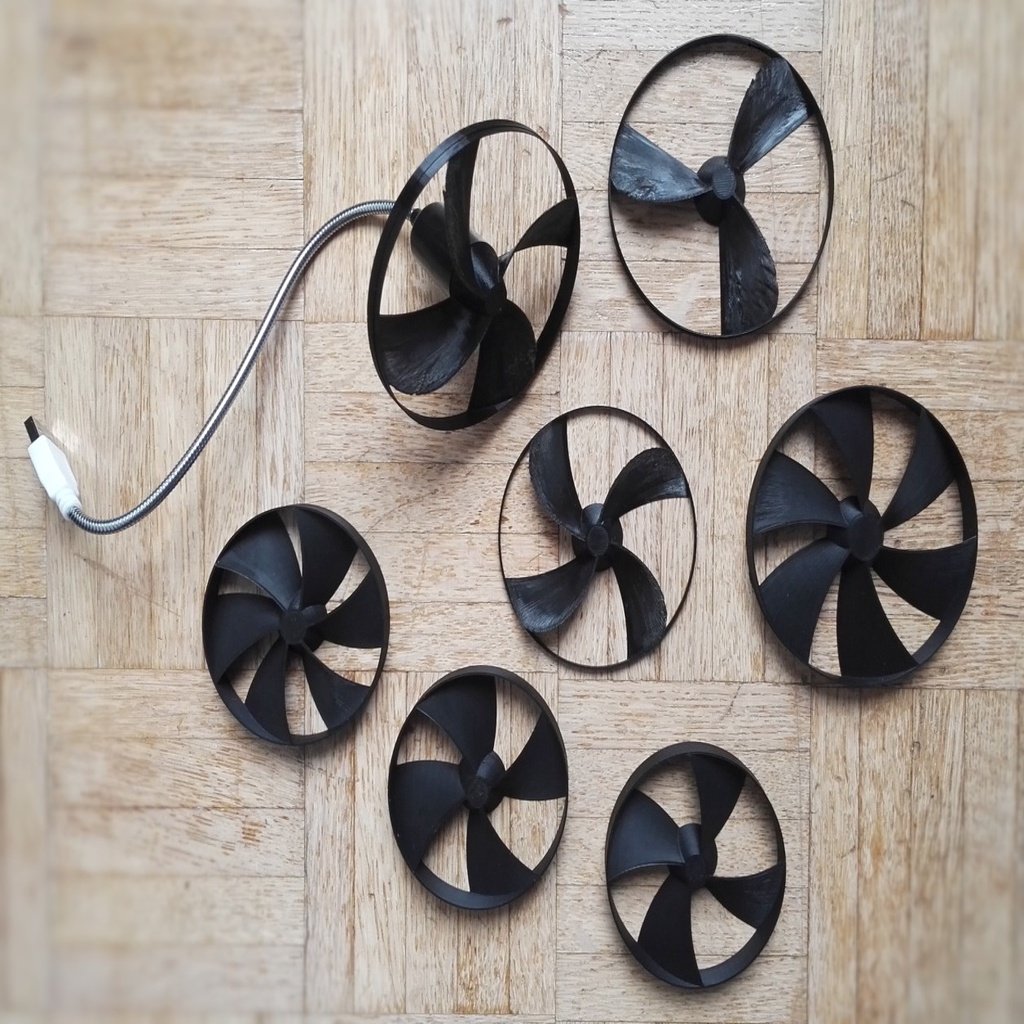
Turbine Propeller Fan Generator v2
thingiverse
This is a revamped version of [CorrugatorSupercilii](https://www.thingiverse.com/CorrugatorSupercilii)'s outstanding [OpenSCAD Turbine Propeller Generator](https://www.thingiverse.com/thing:2187837). The changes are as follows: * Generates the model in a print-friendly orientation. * Option to select between turbine/propeller (air/liquid flows towards the motor/generator) or fan model (air pushed away from motor). * Created customizer-friendly parameters for everything worth tweaking. * Added shroud option. * Better model for large axle holes. * Rewrote the code that generates the trailing blade curve, making it much more efficient now and generating previews in OpenSCAD is more responsive. My immediate goal was to reduce noise level of a very cheap flexible Chinese USB fan that came with floppy foldable blades. Those blades produce a surprisingly good amount of wind for what they are, but they are terribly noisy. After a few prototypes I ended up with something much quieter, it does not achieve the same amount of airflow but I consider the noise reduction more important. **Material selection** The best choice of material depends on what the model will be used for. In my case, I first tried ABS due to its light weight, but although this handles the steep overhanging blades very well at 0.1 mm layers and the prints look great, the result is very stiff and tends to ‘ring,’ amplifying all the motor noises, which makes it a poor choice for a silent fan. Because PLA tends to be even stiffer than ABS, it would probably be even worse in this regard so I didn't even try it. I then tried PETG and this was much better to dampen noises because of its flexibility. The downside is that it is a pain to print models like these with thin steep overhanging surfaces due to the tendency of PETG to curl up on steep overhangs. This could be mitigated with supports, but supports with PETG are also a royal pain due to the stickiness of the material, so I only use them as a last resort. The shroud helps to anchor down the material, but the end result without supports is still pretty ugly as you can see from the photos. On the other hand, I suspect that those bumpy surfaces and jagged edges do help to reduce the noise level. In the end my PETG fans, even though they look kind of ugly, are much more silent than the cheap motor itself. **Some hints for usage and printing** If Customizer is broken yet again on the Thingiverse website, [here are instructions to run it on your own computer](https://www.thingiverse.com/thing:2812634). * `blade_thickness` is the thickness of the blades within each slice of the 3D print. If you set it to the exact thickness of for instance 4 perimeters, then the model will be printed efficiently, especially if you use an even number of perimeters. (Slicers like PrusaSlicer provide the ideal widths for given numbers of perimeters.) For lightweight fans/propellers, set this to the lowest value possible. * The `pitch_angle` is the angle at the tip of the blades, where it is the most shallow. You may be able to avoid supports even for very shallow pitch angles, by printing at thin layer heights and applying cooling, but at some point supports become inevitable. * Despite the optimised code, generating the final models at small `printer_layer_height` values can still take a long time. This value does not need to be exactly the layer height, for instance using 0.2 when printing at 0.1 mm layers will still yield nice results. * I'm no expert in turbine/fan/aerodynamics theory either, so don't expect these models to be ideal. If you know how to make this better, remember that it's open source!
With this file you will be able to print Turbine Propeller Fan Generator v2 with your 3D printer. Click on the button and save the file on your computer to work, edit or customize your design. You can also find more 3D designs for printers on Turbine Propeller Fan Generator v2.
